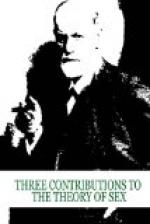In investigating the erogenous zones we have already found that these skin regions merely show the special exaggeration of a form of sensitiveness which is to a certain degree found over the whole surface of the skin. It will therefore not surprise us to learn that certain forms of general sensitiveness in the skin can be ascribed to very distinct erogenous action. Among these we will above all mention the temperature sensitiveness; this will perhaps prepare us for the understanding of the therapeutic effects of warm baths.
Mechanical Excitation.—We must, moreover, describe here the production of sexual excitation by means of rhythmic mechanical shaking of the body. There are three kinds of exciting influences: those acting on the sensory apparatus of the vestibular nerves, those acting on the skin, and those acting on the deep parts, such as the muscles and joints. The sexual excitation produced by these influences seems to be of a pleasurable nature—it is worth emphasizing that for some time we shall continue to use indiscriminately the terms “sexual excitement” and “gratification” leaving the search for an explanation of the terms to a later time—and that the pleasure is produced by mechanical stimulation is proved by the fact that children are so fond of play involving passive motion, like swinging or flying in the air, and repeatedly demand its repetition.[20] As we know, rocking is regularly used in putting restless children to sleep. The shaking sensation experienced in wagons and railroad trains exerts such a fascinating influence on older children, that all boys, at least at one time in their lives, want to become conductors and drivers. They are wont to ascribe to railroad activities an extraordinary and mysterious interest, and during the age of phantastic activity (shortly before puberty) they utilize these as a nucleus for exquisite sexual symbolisms. The desire to connect railroad travelling with sexuality apparently originates from the pleasurable character of the sensation of motion. When the repression later sets in and changes so many of the childish likes into their opposites, these same persons as adolescents and adults then react to the rocking and rolling with nausea and become terribly exhausted by a railroad journey, or they show a tendency to attacks of anxiety during the journey, and by becoming obsessed with railroad phobia they protect themselves against a repetition of the painful experiences.




